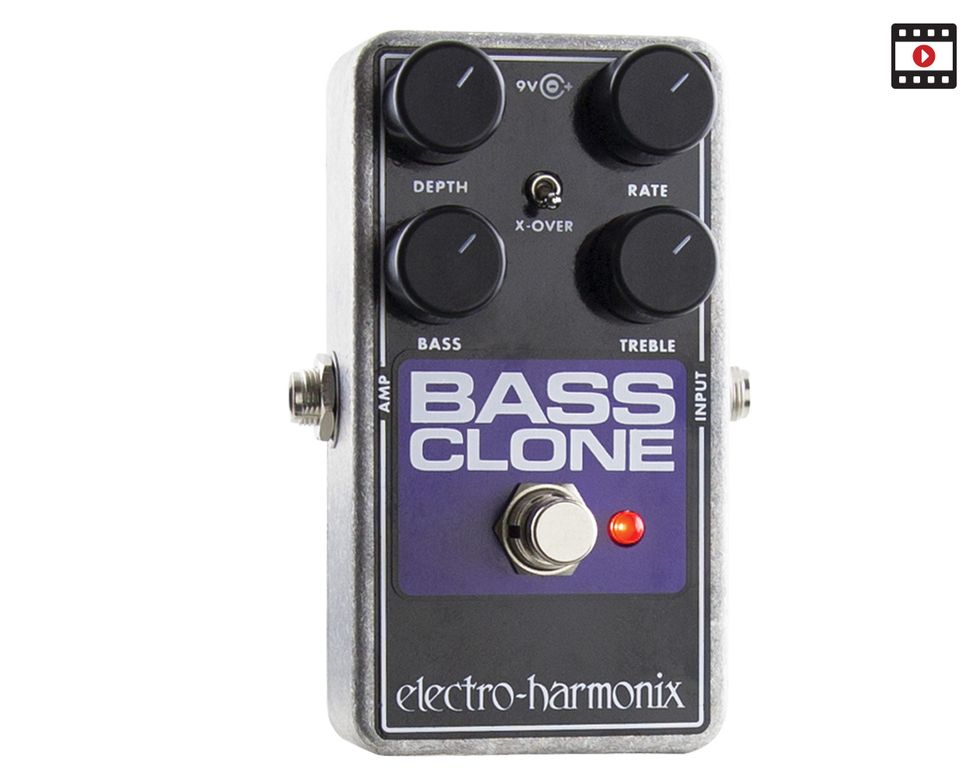Recorded direct into Focusrite Saffire 6 interface into MacBook Pro using GarageBand. A Fender American Professional P bass was used for both clips.
Clip 1 - Depth and rate at 4 o’clock, bass at 1 o’clock, treble at 10 o’clock, x-over engaged.
Clip 2 - Depth and rate at 12 o’clock, bass at 12 o’clock, treble at 12 o’clock, x-over disengaged.
Since the advent of the electric bass, the role of the bassist has certainly evolved in terms of technical sophistication and sonic textures. Adventurous low-enders back in the day were enhancing their signal chain by introducing guitar effects pedals that gave their tone, as well as the music, a unique texture. And in time, pedal builders began fine-tuning their products to cater to the frequency spectrum of basses. Electro-Harmonix, now an elder statesman of effects design, has tweaked a number of their formulas to suit low-end sounds, exemplified in their latest release called the Bass Clone. It’s a take on their mighty modulator Small Clone, but with added features to benefit today’s bassists.
Clone Components
EHX’s Small Clone consists of a depth switch and a rate knob, and the tones gleaned from the pedal provide lush modulations and classic chorus sounds. In lieu of the depth switch, the Bass Clone employs a depth dial with a wide range of modulation. And to its right lies the rate control to manipulate the speed of the modulation.
While this pair of dials is conventional to most chorus pedals, what resides below the duo gives the Bass Clone its own identity. The x-over (aka crossover) switch alters the frequencies in which the effect is applied. In the up position, the chorus effect does not impact the lower frequencies, thereby preserving the foundation, or clarity, of the low end. The down position allows the full spectrum of the signal to be effected.
The other two dials on the Bass Clone are more than simple EQ controls. Low end from just the drysignal can be increased or decreased with the bass knob to help alleviate any potential tone sucking from the engaged effect. Meanwhile, the treble dial boosts or cuts highs from the effected signal and provides the means to change the character of the chorus from warm to bright.
Other features include stout 1/4" jacks and the means to power the box with either a 9V battery or adaptor. The Bass Clone is housed in a tough aluminum shell with the Small Clone’s familiar black-and-purple color scheme.
Love Child of Kurt Cobain and John Scofield
Initial experimentation took place with the Bass Clone placed between a Fender American Professional P bass and a Bergantino B|Amp paired with a Bergantino HD112 cab. Starting with all knobs at 12 o’clock (and the x-over disabled), the tone evoked memories of 1991, when Nirvana’s “Come as You Are” waspumping through the airwaves. Cobain was an avid user of the Small Clone, so it’s only fitting that this next iteration of the EHX classic would share its timbral characteristics.
Ratings
Pros:
Easy to sculpt a wide range of cool chorus effects at a pretty awesome price point.
Cons:
Upper ranges of treble control too hissy for studio applications.
Tones:
Ease of Use:
Build/Design:
Value:
Street:
$68
Electro-Harmonix Bass Clone
ehx.com
Engaging the x-over sparked low-end cut, as it was intended to do, but the cut was somewhat unpleasant. However, this was easily resolved with a boost of the bass control. It managed to balance the unaffected signal with the modulated sound and thereby maintain the foundation of the P’s notes. In fact, this became my preferred setting as I explored the depth and rate dials.
EHX has provided ample amounts of modulation and speed with the aforementioned controls to reward players with loads of tonal possibilities. My inner Star Wars geek smiled when setting the depth at 9 o’clock and the rate around 11 o’clock, which gave the voice of my P bass a villainous, James Earl Jones quality. John Scofield and Charlie Hunter disciples will dig the Bass Clone in its extreme settings, as the pedal can nail the quivering, organ-esque tones made famous by those guitar heroes.
My only concern with the Bass Clone was the hiss produced with the treble control in its upper ranges. To be fair, some audible hiss with an analog chorus is pretty typical depending on the settings. This was easily tempered by dialing it down, but could be problematic when/if brighter tones are desired. Fortunately, the hiss I heard at home was not as evident onstage. For a jazz/blues gig, I swapped the P bass for a Sandberg TM 5-string and ran a backline GK rig. Overall, the EHX pedal provided a nice spice to my tonal cocktail. For instance, I set the depth and rate at 12 o’clock during a dynamic take on Hendrix’s “Little Wing.” This gave a spacey, airy texture to long notes—nicely enhancing the trippy vibe of the tune. Feeling adventurous later on, I maxed the dials and played percussive, staccato chords over Miles Davis’s “So What.” The tones I gleaned that evening impressed my bandmates, and my experience with the Bass Clone enhanced creativity and musical fun via its multiple modulating features.
The Verdict
If it weren’t for the occasional hiss factor, Electro-Harmonix’s Bass Clone would be an absolute home run. It’s impressively user friendly, can produce familiar tones of decades past with ease, and the 2-band EQ and x-over switch offer handy enhancements to the chorus effect. The Bass Clone will suit the professional or the Padawan, and its quality effects come at a price point that thumbs its nose at the competition. Go ahead and check out the other, more-expensive chorus pedals, but once you compare them with what the Bass Clone has to offer, you might end up leaving the store with some cash left in your pocket.
Watch the Review Demo:








![Rig Rundown: AFI [2025]](https://www.premierguitar.com/media-library/youtube.jpg?id=62064741&width=1245&height=700&quality=70&coordinates=0%2C0%2C0%2C0)












 Shop Scott's Rig
Shop Scott's Rig


![Rig Rundown: Russian Circles’ Mike Sullivan [2025]](https://www.premierguitar.com/media-library/youtube.jpg?id=62303631&width=1245&height=700&quality=70&coordinates=0%2C0%2C0%2C0)












































